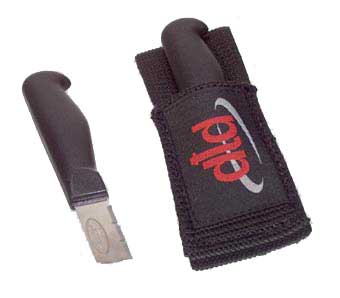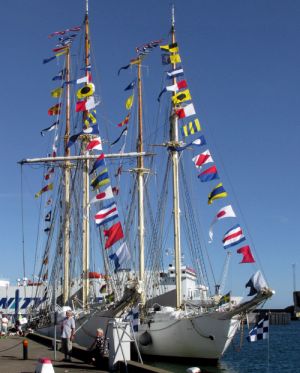Dive Knives

A dive knife should also be considered standard equipment since many dive locations have hazardous monofilament in which you can become entangled. Don't skimp on your knife either - the most commonly found artifact off the New Jersey coast is the cheap dive knife that has slipped from its sheath. When looking at knives in the store, scrutinize the locking mechanism and the sheath. Is it secure and unlikely to release by itself, yet also easy to use? Will it loosen under use, or break with age? Tug at it, and try to see if you can work it loose without actually hitting the release. If you can, then don't buy it. Also, bigger is not necessarily better - many of the best knives on the market are only 10 inches long overall.
Some other features to look for in a knife are:
- Blade shape: blunt tipped blades are safer, while pointed blades are more useful if you are into underwater hunting.
- A good big sturdy handle: you will probably have thick gloves on.
- Metal-butted handle: useful as a tank banger, or light duty hammer.
- Saw edge: for heavy duty cutting.
- Quick release depth compensating straps: much better than buckles.
Some knives only fit into their sheaths one way, that is to say, they have a right side and a wrong side. These are non-starters as far as I am concerned. The knife should lock firmly into its sheath no matter how it is inserted, and you should be able to get it in and out by feel alone, without looking.
A small spare emergency knife is also a prudent thing to carry. I carry a small stainless steel folding knife in my BC pocket, where it is out of the way unless I need it. This particular knife even has a quick-release lanyard to prevent it from getting lost from an open pocket. You can get a similar knife at Sports Authority Dicks for about $25.
The one thing that a dive knife does not need to be is particularly sharp or pointy. For line cutting, the saw teeth on the back of the blade are far more useful than the edge. ( That little line-cutter notch that every manufacturer includes is totally useless. ) If your knife is very sharp and pointy, it will just be that much more dangerous to put back in its sheath on your leg. The ocean will quickly corrode the fine edge off a steel blade anyway.
Tropical divers may get away with wearing their knife on an arm, BC strap, or thigh, but really the best place for a knife is inside the right calf at about 10 o'clock ( lefties - mirror image. ) This location is easily reachable by simply bending the leg, and there is nothing to obstruct removing or replacing the knife in its sheath, and the operation can be performed with one hand. Most importantly, though, on the inside of the leg, the knife is far less prone to snags and entanglements in the water. A sure sign of a freshly minted diver is a huge new knife strapped proudly to the outside of the leg. Some divers keep a knife on their gauge console. This is fine for a small spare, but I would not mount my primary knife this way as it might require both hands to get it out.
On most dives, I find that I never even touch my knife. Needlessly fiddling with it in the water is just a good way to lose it.
My Recommendation
My favorite knife is the Seaquest Z-Lock type, shown above. This knife has all the desirable features described, as well as a very compact streamlined sheath. The blunt-tipped models should be avoided, though. These are made from extremely hard "440" steel, so that they can take a very good edge if you know how to sharpen them. However, this hard steel is also brittle, and I had one snap off like a wine glass after a low fall. Seaquest replaced it right away with a pointed model, as I requested since the pointed model is made from milder "300" steel. Not quite as sharp, but a lot tougher - it will bend rather than break. This is important if you ever want to use it as a pry bar ( not recommended. ) This knife went out of production years ago, but it serves as a model for what you should look for.
Sea Snips

You can read in the dive magazines how these are the greatest thing ... cut through stuff that a knife won't ... blah blah blah. Don't believe it. These lightweight, essentially disposable shears are designed for very limited medical uses - cutting through bandages and similar materials. Sure, you can cut a penny in half with a brand-new pair, but how often is that going to be useful during a dive? They are not and never were designed to cut through tough nylon rope, netting, and many of the other entanglements you might find underwater. The one thing that these shears can cut reasonably well is monofilament, but you can usually just break out of that by pulling on it.
Sea Snips also don't hold up very well. While the blades are more or less rust-proof, the little rivet that holds them together is not, and after a few dives, it will be considerably weakened by corrosion. The result is that if you ever have to actually use your "Sea Snips", they will probably break in your hands. If you are already in an emergency situation, this will make it worse. Using them with thick gloves or mitts may be an issue as well, especially compared to just pulling out a knife.
Some folks say Sea Snips are a useful adjunct to a knife. I say they are just an extra piece of junk to get in your way. Don't waste your money. If you must have a pair of Sea Snips, do yourself a favor and drill out the rivet and replace it with a stainless steel bolt and locking nut.

DIR
The recommended DIR cutting tool is a sawed-off 1/2-inch stub of a kitchen knife. This boggles the mind. I cannot imagine how this lame contraption would be useful in open water. For God's sake, get a real knife. ( In fairness, DIR-F does not recommend this silly thing for open-water use. )

